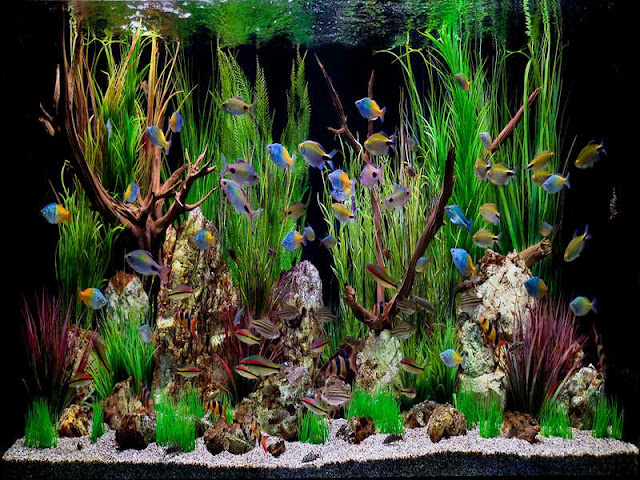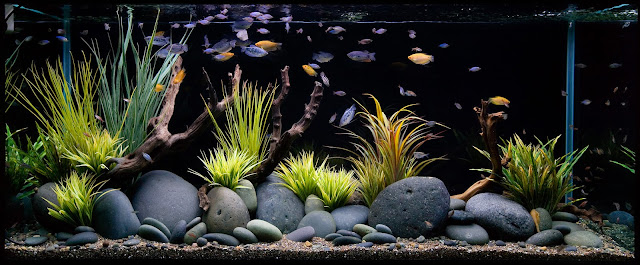This article provides an overview of a
tropical freshwater aquarium: how to set it up, establish plants, feed your fish and maintain the tank.
The Aquarium
Aquarists should understand that their main aim is to keep a highly artificial and confined group of animals and plants in an environment that can change dramatically and quickly with tragic consequences for some or all of the occupants. Yet this can be achieved if a few basic facts are recognized and then applied to counteract any problems that might arise.
Location
The first important consideration is tank location. It should receive some daylight, but is not essential, and it may be maintained perfectly with artificial illumination alone.
Drafty places must be avoided, and so must the tops of radiators, which heat the sand and cause plants to wilt and can overheat a tank too easily. Therefore, the popular window location over a radiator is not recommended.
Substrate
Aquarium gravel with a variable grain size, is the best. It should be deep enough to provide adequate root space for the plants provided, which will vary from 1 to 3 inches.In all but the smallest tanks, 2 inches of depth at the back and less in front is about right.Fill the tank carefully with water free of chlorine.
Heating
Tropical fish need heated water, usually at a temperature of between 21ºC (69ºF) and 23ºC (73ºF). A heater and pre-set thermostat are put in place and switched on.
Stones, rocks and ornaments
These items are almost purely a matter of personal taste but some fish do appreciate places to hide.Remember to sterilize with hot water before using these items.Pots put on their side are often great places for fish to hide.Use your imagination and you can have a great looking tank like the one in the photo on the right.
Planting
Make a diagram of the desired scheme before starting. The higher-growing and larger plants look best at the back and sides (Cabomba, Myriophyllum, and Anacharis). In front, some of the smaller grasses or dwarf varieties of other plants may be used, but it is customary to leave a free swimming space in the center front. Plants serve many purposes. They absorb carbon dioxide (from the fish) and give off oxygen into the water. They also mop up as nutrients the nitrates produced from fish excreta and can hide heater cables in the tank.
Cover/canopy/hood
A cover for your tank is essential as it stops active fish from escaping, prevents moisture loss from evaporation and acts as a housing for the artificial lighting.
Fish
Before introducing any fish you’ll want to decide if you are having a community tank (several different species of fish) or a specialist aquarium featuring only one species. Find out about potential incompatibilities between the various species you are planning to put together.
You’ll also need to estimate how many fish you can accommodate in your aquarium. Measure the surface area of your tank (length x width) and divide by 12. This gives you the number of slender fish 1 inch long (e.g. tetras) your tank will comfortably accommodate.
For fuller bodied fish like goldfish, divide the surface area by 20. Of course you can use half the number of fish 2 inches long and a quarter the number of 4 inch fish etc. And the length should be that of the fully grown fish, not the young fish you are probably putting in your aquarium.
Diet
Whatever you do, don’t overfeed. This causes food to rot, water quality to deteriorate and the fish to suffer. A couple of times a day should suffice with enough food to be eaten within 3 or 4 minutes. Dried foods can be powder or flake with variable amounts of animal/vegetable matter and biscuit meal. Tablets are also available and can be nibbled on by the fish. Live foods include tubifex worms, daphnia, brine shrimp, earthworm and infusoria.
A varied diet is advisable so both dried and live foods should be given to varying degrees depending on your fishes specific requirements.
Maintenance
This is absolutely essential to ensure the continued presence of healthy fish. Regular tank cleaning, monitoring of water quality, thinning of plants when necessary etc etc. Set yourself a schedule and keep to it. You will reap the benefits and enjoy the beauty of your aquarium and lovely fish for many years to come.




Comments
Post a Comment